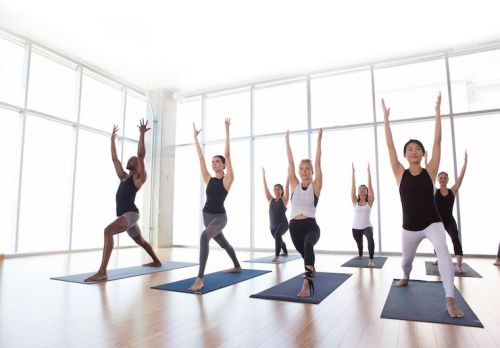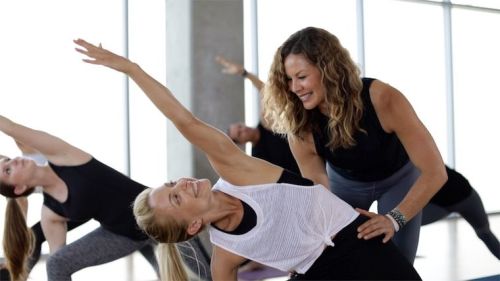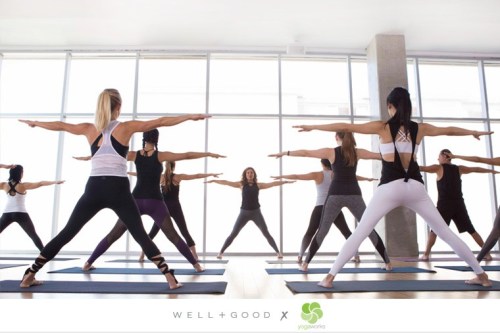I am definitely not a yoga expert—unless being one means you double tap Instagram photos of yogis twisted into seemingly impossible poses with awe (and a touch of envy) on the reg. However, I have spent a decent about of time on the mat, from sessions meant to be so restorative they verge on a nap, to classes that are sweat-dripping-in-your-eyes, heart-poundingly intense.
But the one type of class curiously missing from my repertoire was one specifically geared toward beginners. Like a lot of new yogis, I originally jumped head-first into yoga. My first-ever class was definitely way too advanced for my level of (no) experience—and I hid in the back and hoped for the best.
In an effort to tap more into the internal benefits of yoga, I decided to go all the way back to the basics.
I’ve come a long way since then, but have recently found myself wanting to take my commitment to yoga up a notch. So in an effort to tap more into the internal benefits of yoga (and maybe get one step closer to sticking one of those mind-bendingly bendy poses), I decided to go all the way back to the basics.
I signed up for a YogaWorks Level 1 class, which the managers assured me was suitable for someone completely new to yoga (so it met my fresh-start requirement). As a studio that’s been around for decades (they’re celebrating their 30th anniversary in September) I figured I could trust YogaWorks’ instruction, considering its methodology promises authentic, traditional-style yoga with an emphasis on developing mindfulness.
So, a girl walked into a dimly lit studio armed with a mat and an open mind. Here’s what I learned.
Scroll down for four reasons a back-to-the-basics yoga experience might be for you.

To get more in tune with your body
The first thing I noticed was the pace of the class. It was much slower than your typical vinyasa flow class, which allowed me time to settle into each pose without feeling like I had to rush into the next one to keep up with my neighbor.
In turn, I paid more attention to how my body was feeling (and realized I was a lot more sore from my workout the previous day than I had thought). The instructor, Caitlin Casella, explained to me after class that the unhurried tempo is what often draws more advanced students to take her Level 1 class.
“Some of the usual Level 3 students sometimes take a Level 1 class because it just feels right for their body on that day,” Casella says. “Maybe they’re tired or sore from another workout, or it just feels safe on their body and on their joints.” Check, and check.

To learn the “right” way to do each pose
During the class, Casella dedicated a lot of time to explaining exactly how to line up your body to get into the pose. She had us pay extra attention to the angle of our hips in poses like tree and warrior two, which helped me realize that my version of warrior was more twisted than it needed to be.
“Slower classes allow time for inquiry and playing so you can learn optimal alignment for the pose and the body,” Casella explains. “There might not be one optimal alignment for a specific pose, but there might be an optimal alignment for that pose for your body.”
Learning the right way to position my body ultimately helped me feel like I was getting more out of it (AKA my quads were definitely burning).

To learn something new
If your goal is to nail a handstand, you might think an advanced class is where you need to be. But Casella says many more skilled students return to the lower level classes when they have their sights set on adding a new pose to their arsenal.
“Some students are blown away when they go back to a Level 1 class by what they actually learn,” Casella says. “Advanced students end up learning a lot by slowing down. Think about it like this: You have to go slow to learn how to speak a new language. So many advanced students circle back to level 1 because they’re asking their bodies to do something new.”
 To figure out what mindfulness really means
To figure out what mindfulness really means
The biggest task in my back-to-basics test was to tackle my understanding of mindfulness. I get that yoga is designed to help you clear your mind—but what does that actually look like?
“Some flow classes with music can move into entertainment, and ultimately, entertainment in any form is distraction for your mind,” Casella says. “I think going slower and being still can actually be a more advanced practice because it makes you sit with what’s inside your mind.”
In the YogaWorks 1 class, Casella issued a challenge: Use the slower pace to allow yourself to notice how distracted you get. For me, the answer was a lot. Without having to work so hard to keep up with the class, my brain started churning. Not only was I taking mental notes for what I was going to write in this article (guilty), I was also planning what I wanted to eat for dinner.
But every time my mind wandered, I reminded myself, come back to the breath. (How many times have you heard an instructor say that in a class?)
After, I felt like I finally understood what that meant. Tuning in to my breath wasn’t just another distraction. It helped me pay attention to myself and what my body needed, and ultimately, that’s a way bigger gift than thinking about tomorrow’s to-do list. Because truthfully, it can wait.
In partnership with YogaWorks
Photos: YogaWorks
Sign Up for Our Daily Newsletter
Get all the latest in wellness, trends, food, fitness, beauty, and more delivered right to your inbox.
Got it, you've been added to our email list.





